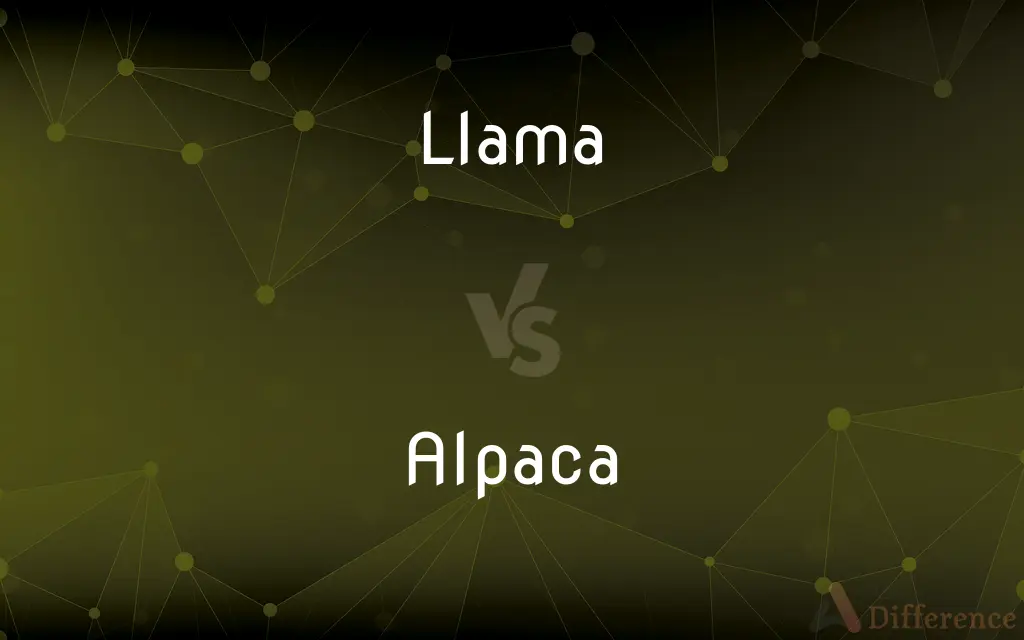Llama vs. Alpaca — What's the Difference?
By Tayyaba Rehman — Updated on September 22, 2023
Llamas are larger, used as pack animals, with longer faces; alpacas are smaller, prized for their wool, and have smushed faces. Both are domesticated South American camelids.

Difference Between Llama and Alpaca
Table of Contents
ADVERTISEMENT
Key Differences
Llamas and alpacas are two distinct species, both native to South America, belonging to the camelid family. Despite their similarities, there are key differences that set them apart, especially in terms of size, purpose, and physical features.
Llamas are notably larger when compared to alpacas. An adult llama can weigh between 290 to 440 pounds, while alpacas usually weigh around 100 to 175 pounds. This size difference makes llamas suitable as pack animals, often used to carry goods over long distances, especially in the Andean regions. In contrast, alpacas have been primarily bred for their fleece, which is soft, luxurious, and can be spun into high-quality yarn.
Physically, llamas have elongated faces and curved ears, giving them a distinct appearance. Alpacas, on the other hand, possess a smushed face and spear-shaped ears. Their wool is also denser and comes in a wider variety of natural colors compared to llamas.
In terms of behavior, llamas tend to be more independent and protective, sometimes used as guard animals for other livestock like sheep. Alpacas are more herd-oriented, sociable, and are less likely to display aggressive behavior. Thus, understanding these differences can assist in determining which animal best suits specific needs and environments.
Comparison Chart
Size
Larger, 290-440 lbs
Smaller, 100-175 lbs
ADVERTISEMENT
Purpose
Pack animal
Wool production
Physical Appearance
Long face, curved ears
Smushed face, spear-shaped ears
Fleece Quality
Coarser
Softer, more colors available
Behavior
More independent, can be guards
Sociable, herd animals
Compare with Definitions
Llama
A large, long-faced animal with curved ears, native to the Andes.
We spotted a llama grazing by the roadside during our trip.
Alpaca
A camelid often confused with the llama but primarily valued for its fleece.
She bought an alpaca scarf during her visit to Peru, impressed by its softness.
Llama
An animal that can be sheared for its wool, though not as fine as alpaca's.
This blanket is made of llama wool and is surprisingly warm.
Alpaca
A creature producing wool in a wide variety of natural colors.
This sweater is 100% alpaca wool and comes in a beautiful natural shade.
Llama
A domesticated South American camelid used primarily as a pack animal.
The group hired a llama to carry their gear up the mountain.
Alpaca
An animal known for its gentle nature and sociable behavior.
The alpaca seemed content among its herd, munching on the grass.
Llama
An herbivorous mammal that can spit when threatened.
The kids giggled when the llama spit at a teasing tourist.
Alpaca
The alpaca (Vicugna pacos) is a species of South American camelid mammal. It is similar to, and often confused with, the llama.
Llama
A robust creature often found in high altitude regions.
The llama seemed unfazed by the thin mountain air.
Alpaca
A long-haired domesticated South American mammal related to the llama, valued for its wool.
Llama
The llama (; Spanish pronunciation: [ˈʎama]) (Lama glama) is a domesticated South American camelid, widely used as a meat and pack animal by Andean cultures since the Pre-Columbian era. Llamas are very social animals and live with others as a herd.
Alpaca
A domesticated South American ruminant mammal (Vicugna pacos or Lama pacos), related to the llama and having fine, long wool.
Llama
A domesticated pack animal of the camel family found in the Andes, valued for its soft woolly fleece.
Alpaca
The silky wool of this mammal.
Llama
A domesticated South American ruminant mammal (Lama glama) related to the camel and having a long neck and small head, raised for its warm wool and used as a beast of burden.
Alpaca
Cloth made from alpaca.
Llama
Any of various related mammals, such as the alpaca and the guanaco.
Alpaca
A fabric that imitates alpaca, made from various natural or synthetic fibers.
Llama
A South American mammal of the camel family, Lama glama, used as a domestic beast of burden and a source of wool and meat.
Alpaca
A sheep-like animal of the Andes, Vicugna pacos, in the camel family, closely related to the llama, guanaco, and vicuña.
Llama
Archaic form of lama
Alpaca
(uncountable) Wool from the alpaca.
Llama
A South American ruminant (Auchenia llama), allied to the camels, but much smaller and without a hump. It is supposed to be a domesticated variety of the guanaco. It was formerly much used as a beast of burden in the Andes, and is also kept on some ranches in the United States.
Alpaca
An animal of Peru (Lama paco), having long, fine, wooly hair, supposed by some to be a domesticated variety of the llama.
Llama
The fleece of the llama{1}, a fine, soft wool-like hair.
Alpaca
Wool of the alpaca.
Llama
Wild or domesticated South American cud-chewing animal related to camels but smaller and lacking a hump
Alpaca
A thin kind of cloth made of the wooly hair of the alpaca, often mixed with silk or with cotton.
Alpaca
Wool of the alpaca
Alpaca
A thin glossy fabric made of the wool of the alpaca, or a rayon or cotton imitation
Alpaca
Domesticated llama with long silky fleece; believed to be a domesticated variety of the guanaco
Alpaca
A domesticated South American camelid bred for its soft fleece.
The alpaca's wool is considered a luxury material in the textile industry.
Alpaca
A smaller relative of the llama with a smushed face and spear-shaped ears.
The children loved feeding the friendly alpaca at the petting zoo.
Common Curiosities
Are llamas and alpacas the same species?
No, they are two distinct species within the camelid family.
Can llamas be used as guard animals?
Yes, llamas can be protective and are sometimes used to guard livestock.
Which animal is more sociable, llamas or alpacas?
Alpacas are generally more sociable and prefer to be in herds.
Are alpaca fibers softer than llama fibers?
Yes, alpaca fibers are often softer and more prized than llama fibers.
Which animal produces more wool colors naturally?
Alpacas produce wool in a wider variety of natural colors compared to llamas.
Can you ride a llama or alpaca?
Llamas can be trained to be ridden, but it's uncommon; alpacas are not typically ridden due to their size.
Which is bigger, a llama or an alpaca?
Llamas are generally larger than alpacas.
Share Your Discovery

Previous Comparison
Harbour vs. Dock
Next Comparison
Acid vs. AlkalineAuthor Spotlight
Written by
Tayyaba RehmanTayyaba Rehman is a distinguished writer, currently serving as a primary contributor to askdifference.com. As a researcher in semantics and etymology, Tayyaba's passion for the complexity of languages and their distinctions has found a perfect home on the platform. Tayyaba delves into the intricacies of language, distinguishing between commonly confused words and phrases, thereby providing clarity for readers worldwide.














































